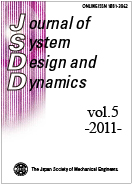Volume 5, Issue 3
Special Issue of Asian Conference on Multibody Dynamics 2010
Displaying 1-11 of 11 articles from this issue
- |<
- <
- 1
- >
- >|
Special Issue of Asian Conference on Multibody Dynamics 2010
-
2011 Volume 5 Issue 3 Pages 388
Published: 2011
Released on J-STAGE: April 28, 2011
Download PDF (121K)
Papers
-
2011 Volume 5 Issue 3 Pages 389-402
Published: 2011
Released on J-STAGE: April 28, 2011
Download PDF (809K) -
2011 Volume 5 Issue 3 Pages 403-415
Published: 2011
Released on J-STAGE: April 28, 2011
Download PDF (734K) -
2011 Volume 5 Issue 3 Pages 416-428
Published: 2011
Released on J-STAGE: April 28, 2011
Download PDF (648K) -
2011 Volume 5 Issue 3 Pages 429-440
Published: 2011
Released on J-STAGE: April 28, 2011
Download PDF (512K) -
2011 Volume 5 Issue 3 Pages 441-449
Published: 2011
Released on J-STAGE: April 28, 2011
Download PDF (644K) -
2011 Volume 5 Issue 3 Pages 450-460
Published: 2011
Released on J-STAGE: April 28, 2011
Download PDF (1067K) -
2011 Volume 5 Issue 3 Pages 461-473
Published: 2011
Released on J-STAGE: April 28, 2011
Download PDF (850K) -
2011 Volume 5 Issue 3 Pages 474-485
Published: 2011
Released on J-STAGE: April 28, 2011
Download PDF (670K) -
2011 Volume 5 Issue 3 Pages 486-500
Published: 2011
Released on J-STAGE: April 28, 2011
Download PDF (2657K) -
2011 Volume 5 Issue 3 Pages 501-512
Published: 2011
Released on J-STAGE: April 28, 2011
Download PDF (1012K)
- |<
- <
- 1
- >
- >|
